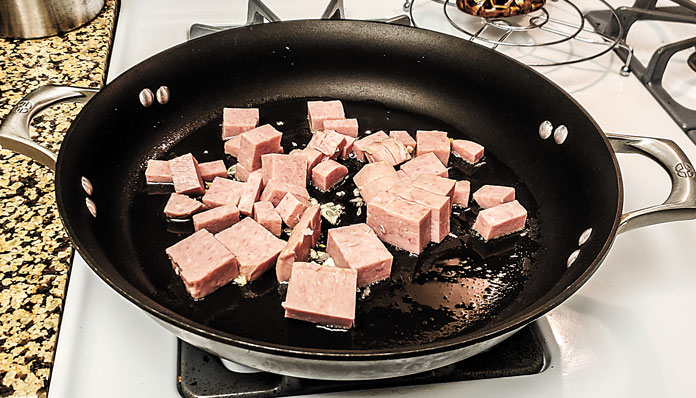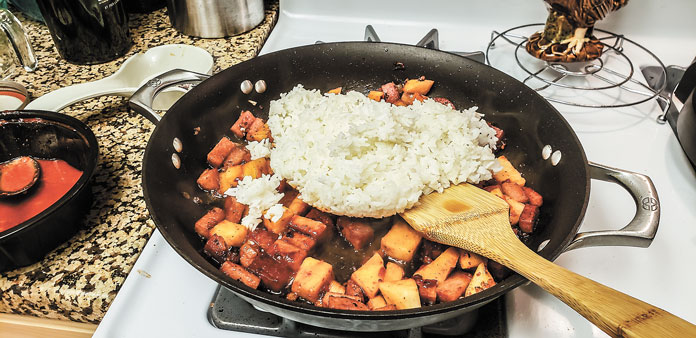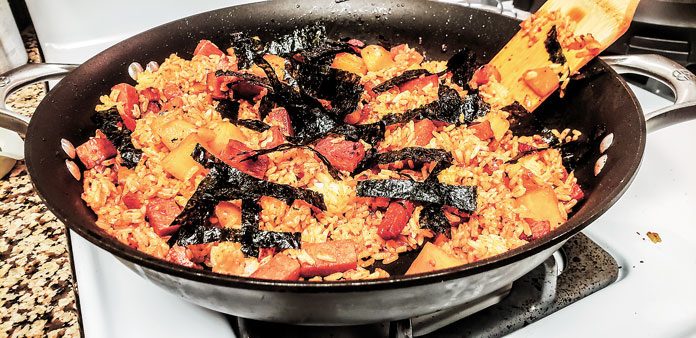with Chef Robert Larios
Photography by Patricia M. Larios
It’s time to break into Korean cuisine with one of the most popular dishes – kimchi fried rice. Kimchi is a spicy Korean condiment, a tangy, spicy fermented cabbage that is the heart of Korean cuisine; it is used in many dishes. It’s an awesome side for any meal, or as a meal of its own. The rice is best when it is cooked in advance and chilled, because the grains will stick less to the pan and each other.
Notice I included butter in the ingredients list. That’s not a typo. Although butter is not part of the traditional cuisine, it is becoming a staple of modern Korean cooking.
 ¡Buen provecho!
¡Buen provecho!
Kimchi Fried Rice (Kimchi Bokkeumbap)
Step 1
Heat avocado oil in large skillet (a non-stick wok is ideal) over high heat. Stir Spam into skillet and reduce heat to medium. Cook and stir Spam and then add green onion until the Spam is browned and onion is fragrant, 1 to 2 minutes.

Step 2
Stir kimchi and gochujang into Spam mixture and cook until warmed through and fragrant, 2 to 4 minutes. Add rice; cook and stir until rice is heated through and coated with gochujang, 3 to 5 minutes more.

Step 3
Drizzle sesame oil over rice mixture and stir to coat. Garnish with green parts of green onion and nori.
Melt 1 teaspoon butter in a skillet over medium-high heat. Crack egg into the pan and cook until white is completely set and yolk is thick, 3 to 4 minutes. Place egg over fried rice.

Enjoy!

Ingredients
|
Food Lover’s Dictionary
Bibliography: Copyright Barron’s Educational Services, Inc. 2009, adapted from The New Food Lover’s Companion, 2007, by Sharon Tyler Herbst and Ron Herbst. Recipe: https://www.allrecipes.com/recipe/237053/kimchi-fried-rice-kimchi-bokkeumbap/Accessed July 01, 2020 |
Cooking Tidbit: If you don’t have access to avocado oil, canola oil is a good alternative. I used Spam in this recipe, but shrimp, chicken and beef can be used. Or you may decide to eliminate them all in your version.
Food Quote: “I’m really happy to see the explosion of interest in Korean food, and this hybrid Korean-American food.”
– Anthony Bourdain




 Kimchee; kimchi [KIHM-chee]: This spicy-hot, extraordinarily pungent condiment is served at almost every Korean meal. It’s made of fermented vegetables – such as cabbage or turnips – that have been pickled before being stored in tightly sealed pots or jars and buried in the ground. It’s dug up and used as needed. Commercial kimchi can be purchased in Korean markets. It will keep indefinitely in the refrigerator.
Kimchee; kimchi [KIHM-chee]: This spicy-hot, extraordinarily pungent condiment is served at almost every Korean meal. It’s made of fermented vegetables – such as cabbage or turnips – that have been pickled before being stored in tightly sealed pots or jars and buried in the ground. It’s dug up and used as needed. Commercial kimchi can be purchased in Korean markets. It will keep indefinitely in the refrigerator.










